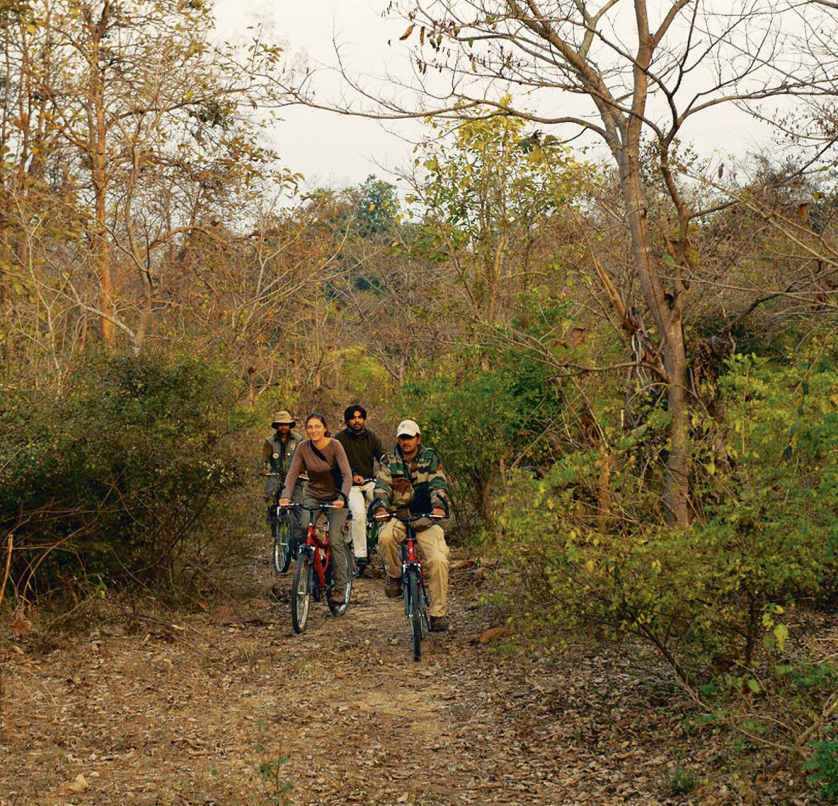India is a haven of biodiversity. The top 5 wildlife sanctuaries in India are home to several species that are endemic to the Indian subcontinent. From tigers to elephants, rhinos to bears, cobras to hornbills and more… here is a list of Tiger Safari India’s top five wildlife sanctuaries in India that you must visit at least once in your lifetime.
#1) Kanha National Park, Madhya Pradesh – Central India
Prime tiger territory, Kanha is one of the largest national parks in Central India. It is thick with shrubs, climbers, and creepers running over tree branches, which creates a dense canopy of greenery, punctuated by several lakes and water holes. Naturalists believe that as tiger numbers start to dwindle, Kanha (along with Corbett and Nandhaur) will remain one of the last tiger populated jungles. The Kanha-Pench tiger corridor is one of the healthiest and safest passages of migration for these felines and as a result, strong and resilient genes proliferate here.
Kanha National Park has over 500 hard ground swamp deer, thanks to a massive conservation effort. It also has a sizeable population of Gaur (The Indian Bison) and Leopards. The dense foliage and grass is a perfect habitat for these stealthy animals to stalk their prey. The other major predator in Kanha is the Wild Dog, known locally as the Dhole. Primates and reptiles are plentiful and the birding in Kanha is mind-blowing. There are over 300 species of birds in Kanha. One constantly sees flashes of color as Teals, Hornbills, Warblers, Bee-Eaters, Barbets and many other birds cross your line of vision. Several birds of prey, especially eagles, abound in Kanha as well.
#2) Bandhavgarh National Park, Madhya Pradesh – Central India
Thick bamboo groves are interspersed by groves of Sal and Mahua trees whose scent mingles with the jungle’s earthy fragrance. Bandhavgarh blends several species of vegetation, including tropical moist and tropical dry deciduous forest. As a result, it has become a breeding ground for over 600 species of flowering plants. Over thirty-five species of mammals, 250 species of birds, 75 species of butterflies, and of course, the ultimate predator – the tiger.
Today, Bandhavgarh national park has one of the highest population densities of the tiger in the world. It is a key reserve for the Project Tiger wildlife conservation initiative. The Dhole (Indian Wild Dog), Bengal Fox, Leopards, Mongooses, Hyenas, and Jackals are the other predators that roam the forest. It is also rampant with several species of deer, wild boar, squirrels, bandicoots , and primates. Bandhavgarh is a Raptor haven. Bird lovers, beware. You may never leave this enchanted forest. From Sapphire Flycatchers to Golden Orioles, the Indian Hornbill to the Hoopoe, it’s a kaleidoscope of vivid hue and cry.
#3) Corbett National Park, Uttaranchal – North India
 Corbett’s landscape and legend lend itself to the wildlife lover’s imagination. It is the oldest national park in India. This park is named after Jim Corbett national park, who was ironically a big game hunter turned ardent conservationist, who spent several years in the area and came to call it his own. This park is a natural habitat for herds of elephants, tigers, the Asiatic Black Bear, Leopards, and several other species.
Corbett’s landscape and legend lend itself to the wildlife lover’s imagination. It is the oldest national park in India. This park is named after Jim Corbett national park, who was ironically a big game hunter turned ardent conservationist, who spent several years in the area and came to call it his own. This park is a natural habitat for herds of elephants, tigers, the Asiatic Black Bear, Leopards, and several other species.
It was also the first park to launch the Project Tiger wildlife conservation program and is one of the thirteen parks that make up the World Wildlife Fund for Nature’s Terai Arc Landscape program. Corbett is critical for the survival of three of the Indian subcontinent’s big game species, which include the tiger, the Asiatic Black Bear and the Asian Elephant.
Several species of deer, otters and the extremely rare Himalayan Pangolin inhabit this terrain. Corbett has its fair share of reptiles and its star species include the King Cobra and large breeds of Pythons that are capable of eating prey as large as a deer. Several migratory birds flock here in the winter months and you can often find herons, ducks, and egrets. One of the rarer inhabitants of the bird family that is found in Corbett is the Great Indian Hornbill. It is the largest among the eight species of Hornbill that are found on the Indian Subcontinent and is a majestic bird – especially when it is in flight.
#4) Tadoba National Park
#5) Ranthambore National Park
The dry deciduous forests of Ranthambore, interspersed with some of India’s largest and oldest Banyan trees, evoke an aura of romance. Scrubby foliage and thorny brush give way to grasslands, which make up this beautiful wilderness. Nestled within the Aravalli mountain range, it has over 500 species of plants and is a thriving ecosystem.
Ranthambore national park is teeming with wildlife and is one of the best-known parks for tigers. The park is also full of other species of flora and fauna, particularly deer, primates, birds and crocodiles. Over two hundred species of birds have been recorded, both resident and migratory. The parks, many water bodies draw a large number of birds to their banks. Waterfowl like pelicans, storks, ibises, and cormorants are often seen, especially in the winter season.
The five top wildlife sanctuaries in India are so amazing that they warrant more than one trip! So pull out those binoculars, pack those bags and give us a buzz. Your Tiger Safari India experience of a lifetime awaits.










